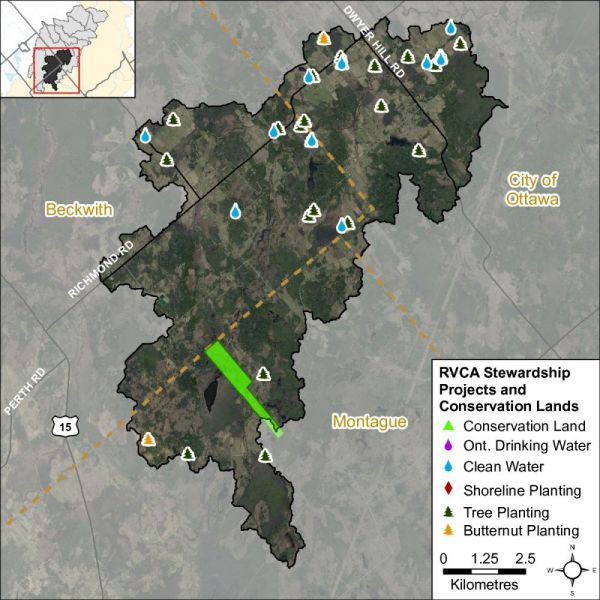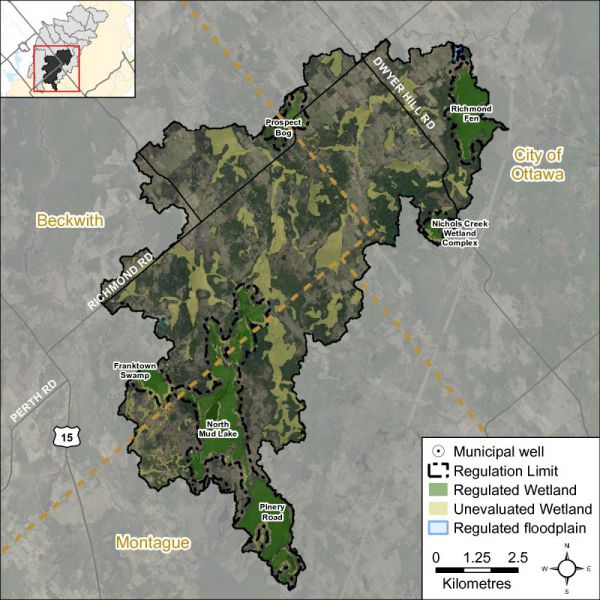5.0 Kings Creek Catchment: Stewardship and Water Resources Protection
The RVCA and its partners are working to protect and enhance environmental conditions in the Jock River Subwatershed. Figure 50 shows the location of all stewardship projects completed in the Kings Creek catchment along with sites identified for potential shoreline restoration.
5.1 Rural Clean Water Projects
From 2010 to 2015, two well upgrades, two windbreak buffers, one septic system replacement and one clean water diversion project were completed. Between 2004 and 2009, two well upgrades, one septic system replacement, one well decommissioning and one well replacement were completed. Total value of all 11 projects is $65,519 with $14,786 of that amount funded through grant dollars from the RVCA.
5.2 Private Land Forestry Projects
The location of RVCA tree planting projects is shown in Figure 50. From 2010 to 2015, 16,900 trees were planted at seven sites. Between 2004 and 2009, 15,600 trees were planted at three sites and prior to 2004, 74,560 trees were planted at 13 sites, In total, 107,060 trees were planted resulting in the reforestation of 52 hectares. One of these projects was completed within the 30 metre riparian zone of the Jock River. Total value of all 23 projects is $322,147 with $99,138 of that amount coming from fundraising sources.
Through the RVCA Butternut Recovery Program, an additional 20 butternut trees were planted in the Kings Creek catchment (Figure 50) between 2004 and 2015, as part of efforts to introduce healthy seedlings from tolerant butternuts into various locations across Eastern Ontario.
5.3 Valley, Stream, Wetland and Hazard Lands
The Kings Creek catchment covers 91 square kilometres with 16.5 square kilometres (or 18 percent) of the drainage area being within the regulation limit of Ontario Regulation 174/06 (Figure 51), giving protection to wetland areas and river or stream valleys that are affected by flooding and erosion hazards.
Wetlands occupy 23.4 sq. km. (or 26 percent) of the catchment. Of these wetlands, 9.1 sq. km (or 39 percent) are designated as provincially significant and included within the RVCA regulation limit. This leaves the remaining 14.3 sq. km (or 61 percent) of wetlands in the catchment outside the regulated area limit.
Of the 143.1 kilometres of stream in the catchment, regulation limit mapping has been plotted along 26.7 kilometers of streams (representing 19 percent of all streams in the catchment). Some of these regulated watercourses (21.7 km or 15 percent of all streams) flow through regulated wetlands; the remaining 5 km (or 19 percent) of regulated streams are located outside of those wetlands. Plotting of the regulation limit on the remaining 116.4 km (or 81 percent) of streams requires identification of flood and erosion hazards and valley systems.
Within those areas of the Kings Creek catchment subject to the regulation (limit), efforts (have been made and) continue through RVCA planning and regulations input and review to manage the impact of development (and other land management practices) in areas where “natural hazards” are associated with rivers, streams, valley lands and wetlands. For areas beyond the regulation limit, protection of the catchment’s watercourses is only provided through the “alteration to waterways” provision of the regulation.
5.4 Vulnerable Drinking Water Areas
The Kings Creek drainage catchment is considered to have a Highly Vulnerable Aquifer. This means that the nature of the overburden (thin soils, fractured bedrock) does not provide a high level of protection for the underlying groundwater making the aquifer more vulnerable to contaminants released on the surface. The Mississippi-Rideau Source Protection Plan includes policies that focus on the protection of groundwater region-wide due to the fact that most of the region, which encompasses the Mississippi and Rideau watersheds, is considered Highly Vulnerable Aquifer.
For detailed maps and policies that have been developed to protect drinking water sources, please go to the Mississippi-Rideau Source Protection Region website at www.mrsourcewater.ca to view the Mississippi-Rideau Source Protection Plan.

